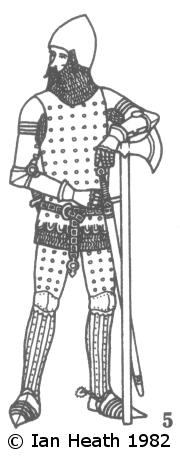SIR MILES STAPLETON d.1364
An extract from Armies of the Middle Ages, Volume 1by Ian Heath


5. SIR MILES STAPLETON d.1364
Sir Miles’ armour, from his now lost brass, contains many interesting features not least of which is his studded body defence, indicating that in this instance the coat-of-plates normally hidden beneath the surcoat has actually become part of it in the form of a brigandine. This was constructed of small overlapping metal (or sometimes baleen) plates rivetted to a cover and lining of fabric, rich materials such as velvet, silk and satin often being used, and it is the gilded rivet heads that can be seen here; a 15th century brigandine preserved in Milan comprises as many as 3,827 plates and over 7,000 rivets. As proof of their defensive capabilities brigandines used to be tested by having crossbow bolts fired at them; the statutes of the armourers of Angers (1448) state that brigandines proof against large crossbows weighed 26-27 lbs, those proof against smaller crossbows and longbows weighing 18-20 lbs. The name brigandine itself derives from the Italian word for a lightly-armed foot-soldier, a brigante, which was also the source of our words ‘brigand’ and ‘brigade’.
Other points of interest about his armour are the articulated epaulières at the shoulder, which first appeared c. 1335 and had generally replaced the besagews described under figure 3 by the mid-14th century; the plate gauntlets; and the studded leather armour worn on the lower leg. Clearly such leather armour remained relatively common until late in the century, Chaucer mentioning quirboily jambeux in his ‘Rime of Sir Thopas’. See also note 32. Plate gauntlets, made chiefly of iron or latten, usually based on a leather foundation, had articulated finger pieces by mid-century when the so-called ‘hour-glass’ gauntlet, with the back and flared cuff both formed by a single large plate, first appeared. After c. 1370 this type of gauntlet was virtually universal, sometimes being fabric-covered. The knuckles and finger joints were often armed with spikes called gads or gadlings, which can be seen on many contemporary effigies and brasses.
The axe he carries is from the Hastings brass, where it is held by Roger Lord Grey of Ruthyn. Called indiscriminately by the names axe, gisarme and sparthe, this was a major knightly weapon of the Hundred Years’ War. It could be either long-handled as here, with a heavy blade (Chaucer’s ‘Knight’s Tale’ mentioning a sparthe of 20 lbs weight), or else a short-handled weapon 24-32 inches long often recorded being used in conjunction with the shortened lance, as at Auray in 1364 where Olivier de Clisson earned his reputation as ‘The Butcher’ by his adroit handling of such an axe. With a spike added at the end of the shaft the axe became a hache de créqui to the French. On horseback it would be carried in a ring to the left of the saddle-bow, Chaucer recording that a knight might carry both an axe and a mace in this way.